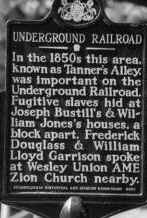|
 
|
Rising
Free
African
American History
in South Central
Pennsylvania:
the 19th Century
|
Harrisburg's Role on the
Trail to Freedom ~ part 2
by T. R. McIntosh
Harrisburg, Pennsylvania, February 2002
|
T. R.
McIntosh --"Mac"-- taught
in the Harrisburg School District for more than forty years before his
recent retirement. Decrying the lack of references to ethnic minorities and
women in his school social studies texts, Mac supplemented his teachings
with material from his extensive reference collection. The following
reference article was produced as a supplement to his session on
Harrisburg's developing anti-slavery role at the February 2002 Underground
Railroad and Abolition Seminars at Gettysburg, Pennsylvania. This is the second of two parts.
|
Significant Dates
for Harrisburg and Dauphin County
- 1825
- Riot in Harrisburg when a man from Maryland lodged a captured runaway slave in the jailhouse in Harrisburg. Fists, clubs, and pistols were involved. Nineteen Black men were arrested, sixteen were tried, twelve were convicted and four were acquitted, eleven were sent to jail and sentenced to the treadmill, and one escaped.
- 1848
- State Convention of Colored Citizens in Harrisburg. Many were connected with the Underground Railroad.
- 1834-1892
- Thomas Morris Chester, native of Harrisburg. Illustrious career as Civil War newspaper correspondent, educator in Africa,
traveler in Europe, admitted to English bar as lawyer there, became first African-American lawyer to practice before the Pennsylvania Supreme Court in 1881.
- 1825-1900
- William Howard Day, important Black leader in Harrisburg from 1870 until his death. First African-American on Harrisburg School Board (1878), serving as President 1891-1893.
- 1872
- William Still published definitive account, entitled The Underground Rail Road, about that phase of American history. Still, James Forten, and Robert Purvis were the three greatest African-American Pennsylvania Abolitionists.
- 1885
- Dauphin County Centennial Celebration recognized Harrisburg's African-American (then entitled "Colored") population, including:
6 "Colored" Churches
2 "Colored" Schools: Lincoln (60 students) and Calder (50 students). These would later be replaced by the Wickersham School.
Cornet Band of Steelton (20 members) in the Parade
Hercules Centennial Association and Club (6 Committee members and 100 members) in the parade
Daniel Elliot, "Colored Cow Boy," promoting a Harrisburg cattle dealer's business in the parade.
- 1886
- James H. W. Howard published Bond and Free: A True Tale of Slave Times. First Harrisburg edition is very rare and fetches more than a thousand dollars when one is sold. The 1969 reprint by Mnemosyne Publishing Company of Miami, Florida, is also hard to find.
- 2001
- Mayor Stephen R. Reed unveiled plans for a National Museum of African-American History in Harrisburg. Early in 2002 he appointed Fred Clark, distinguished Harrisburg educator and political figure, to chair the project.
Go to:
Significant Dates for Pennsylvania African-American History (part 1)
Bibliography on Pennsylvania African-American History
Bibliography on Harrisburg & Dauphin County |
Afrolumens Project Home | Enslavement | Underground Railroad |
19th Century|
20th Century
Original material on this page copyright 2003-2004 Afrolumens Project
|
